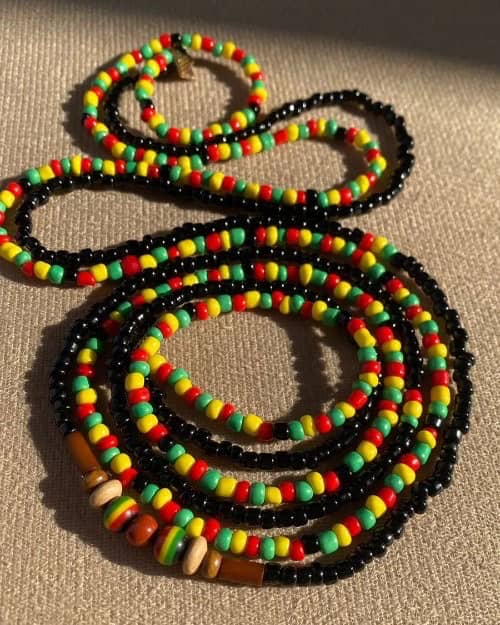The Cultural Significance of Waist Beads for African Women
Waist beads, known as “ileke idi” or “jigida” in Nigeria and “baya” in other parts of Africa, are far more than mere decorative items. Traditionally crafted from beads and strings, and sometimes adorned with decorative stones, these waist beads carry deep cultural and symbolic meaning that has been passed down through generations.
In many African cultures, beads are not just beautiful accessories; they are powerful symbols that convey the values, traditions, and beliefs of a community. Each bead, from its color to its arrangement, holds specific significance. For instance, white beads often represent purity, light, and truth, while blue beads symbolize loyalty, harmony, and peace. The act of wearing waist beads was historically done with intention, reflecting the wearer’s connection to their cultural heritage and the meanings associated with their beads.
Today, waist beads have seen a resurgence in popularity, particularly among women who wear them for various reasons, such as monitoring their weight or simply appreciating their aesthetic appeal.
Despite their modern uses, it’s important to recognize that waist beads have a rich history and cultural significance that trace back to African traditions. So, what exactly is waist beads’ historical and cultural significance to us Africans? Understanding this can deepen our appreciation for these beautiful ornaments and their role in our heritage.
The Origin of Waist Beads
Waist beads are symbols of lineage, womanhood, and tradition, often passed down through generations. Each strand of beads carries a unique story, crafted from various materials such as glass, stones, cowries, and even precious elements like ivory or shells. These beads are not just for adornment—each color and design is imbued with meaning. For many African women, wearing waist beads signifies important milestones in life, such as coming of age, fertility, and sensuality.
 Photo: Instagram/damballah_062
Photo: Instagram/damballah_062 The exact origins of waist beads remain uncertain. Still, historical evidence strongly suggests their roots are deeply embedded in African culture, with their use dating back to at least the 15th century. Some scholars propose that ancient Egypt could be the birthplace of waist beads, which were known as “girdles” and symbolized status among women.
These early versions were made from a variety of materials, including clay, bones, cowries, and precious stones, which were also used to craft other adornments like headpieces, necklaces, and anklets. With the introduction of glass beads in the 12th century, waist beads evolved into the forms more commonly seen today.
Waist beads were initially popularized specifically in West Africa, particularly among the Yoruba people of Nigeria. Then, the tradition of wearing waist beads extended to other West African countries such as Ghana, Senegal, and even parts of South Africa.
Throughout history, African women and girls have adorned themselves with waist beads, a practice that has been sustained for centuries due to the deep personal, spiritual, and cultural connections these beads represent. Waist beads are also cherished for the confidence they instill in women, making them not just a cultural artifact but a powerful symbol of identity and self-assurance.
The Cultural Significance of Waist Beads for African Women
Waist beads are deeply rooted in the cultural practices of many African tribes and carry profound significance. The waist accessory symbolizes femininity, fertility, sensuality, weight management, fashion, and body decoration.
For many African communities, waist beads play a vital role in marking significant life events. For example, during coming-of-age ceremonies, young girls receive waist beads to signify their transition into womanhood. These beads not only highlight their new status but also celebrate their evolving responsibilities within their community.
Contrary to some misconceptions, waist beads were never viewed as negative or “diabolical.” Historically, they were worn for practical reasons, including tracking menstrual cycles, monitoring pregnancy, managing diet, and even, in some cases, for birth control. This practical use underscores the beads’ role beyond mere fashion accessory.
The tradition of wearing waist beads extends to children as well. It was common for mothers to adorn their young daughters with waist beads to accentuate their waists as they grew. This practice continues today, reflecting the enduring cultural importance of waist beads.
 Photo: Instagram/magicxmegan
Photo: Instagram/magicxmegan Waist adornments also carried symbolic meanings that went beyond practicality. In various cultures, the type of material used for waist ornaments could signify social status, special occasions, profession, or wealth.
In Yoruba culture, for instance, waist beads hold a special place, especially in the context of marriage. During traditional Yoruba wedding ceremonies, the bride is adorned with waist beads to symbolize her purity, fertility, and transition from girlhood to womanhood. The beads are often given to her by female family members, marking her readiness for marriage and motherhood. Additionally, these beads serve as a subtle form of communication between husband and wife, with their movement and sound conveying affection and intimacy.
Waist beads are believed to carry spiritual significance and energy. In Yoruba culture, waist beads are traditionally worn to enhance a woman’s fertility and allure. They are thought to attract positive energies and blessings, especially within the context of marriage. The practice of wearing waist beads during intimate moments is said to strengthen the bond between husband and wife, serving as a gentle reminder of the bride’s heritage and her roles as a wife and mother.
Interestingly, the tradition of wearing waist beads also included men. Men used waist adornments to signify their social status and roles within their communities. However, over time, the focus has shifted, and waist beads are now predominantly associated with women. Despite this change, men can still choose to wear them, preserving this important cultural tradition.
Today, waist beads are celebrated for their rich cultural and spiritual significance. Waist beads have become a cherished symbol of African heritage, helping women reconnect with their roots. Whether worn for cultural, spiritual, or personal reasons, waist beads remain a beautiful and enduring tradition. The decorative accessory embodies a blend of history, culture, artistry, and spirituality, continuing to inspire and captivate people around the world.
Even as the significance of waist beads has evolved, they retain their powerful role as symbols of cultural pride and femininity. Many African women wear them as a way to honor their heritage, celebrate their bodies, and continue the traditions of their ancestors. For others, waist beads represent body positivity and self-expression, merging ancient customs with contemporary identity.
Photo: Beadsbymaji
You May Also Like:
Your Ultimate Guide To Different Types Of Earrings
December 14, 2025Denim Accessories That Will Steal The Spotlight This Fall
September 24, 202515 Ballet Flats Worth Adding to Your Closet
September 9, 2025The Best Bags to Pair with Your Summer Dresses
July 24, 2025Brooches Are Back For Women! Here’s How To Style Them
February 18, 2025How to Tie Gele in Different Styles — A Complete Guide
August 30, 202411 Jelly Sandals to Add to Your 2024 Summer Footwear Collection
July 11, 202415 Mesh Flat Shoes Worth Splurging This Summer
June 24, 2024Women's Glasses Trends You Need to Know
April 26, 2024Why Does Oversized Tote Bags Seem Like a Celebrity Staple?
April 9, 202418 Black-Owned Handbag Brands to Know
March 6, 202411 Wireless Bras You'll Actually Love to Wear
February 21, 2024Esther Ejoh is a Fashion Editor at Fashion Police Nigeria, where she writes all things fashion, beauty, and celebrity style, with a sharp eye and an even sharper pen. She’s the girl who’ll break down a Met Gala look one minute, rave about a Nigerian beauty brand the next, and still find time to binge a movie or get lost in a novel. Style, storytelling, and self-care? That’s her holy trinity.






